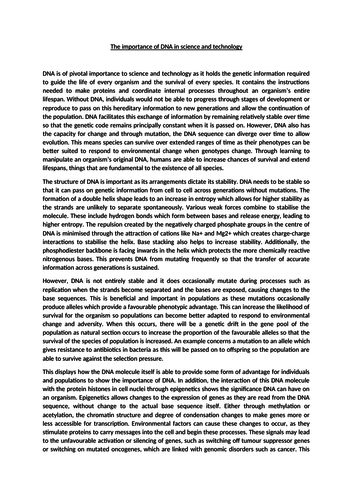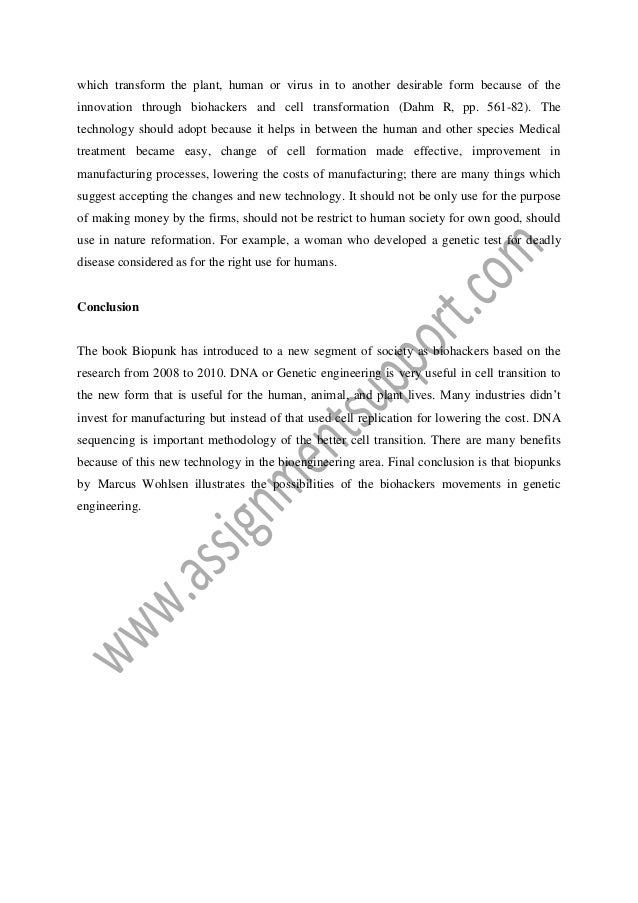
More College Papers
There are four different nucleotides. Each one consists of a deoxyribose 5-carbon sugar, a phosphate group, and a nitrogenous base- adenine, guanine, cytosine, or thymine. The DNA molecule consists of 2 strands twisted together into a double helix, much like a twisted ladder. The phosphate and the sugar molecules make up the sides of the ladder ii. Structure: Mostly the DNA structure is double stranded in both eukaryotes and prokaryotes. However, in some viruses DNA is single stranded. DNA is a double stranded molecule held together by weak bonds between base pairs of nucleotides. The four nucleotides in DNA contain the bases: adenine (A), guanine (G), cytosine (C), and thymine (T). iii. Shape:Estimated Reading Time: 7 mins DNA is a term used for deoxyribonucleic acid and it is the genetic material of all organisms, it is the molecule of life and it determines all of our physical characteristics. DNA is present in every single form of life
Other Popular Examples
· The three-dimensional structure of DNA – the double helix – arises from the chemical and structural feature of its two polynucleotide chains. Because these two chains are held together by hydrogen bonding between the bases on the different strands, all the bases are on the inside of the double helix, and the sugar-phosphate backbones are on the outside The Structure of DNADNA, or deoxyribonucleic acid, is the hereditary material in humans and almostall other organisms. Nearly every cell in a person's body has the same DNA. Most DNAis located in the cell nucleus (it is called nuclear DNA), but a small amount of DNAcan also be found in the mitochondria (U.S. National Library of Medicine, ) · The DNA structure of everyone's DNA is same the only difference is on the base pairs and hence the development of the different DNA sequences. The same DNA fingerprint exists on every cell, tissue and organ of an individual. No alterations can be made on a DNA fingerprint by any treatment that is known

· The three-dimensional structure of DNA – the double helix – arises from the chemical and structural feature of its two polynucleotide chains. Because these two chains are held together by hydrogen bonding between the bases on the different strands, all the bases are on the inside of the double helix, and the sugar-phosphate backbones are on the outside · The DNA structure of everyone's DNA is same the only difference is on the base pairs and hence the development of the different DNA sequences. The same DNA fingerprint exists on every cell, tissue and organ of an individual. No alterations can be made on a DNA fingerprint by any treatment that is known DNA is a term used for deoxyribonucleic acid and it is the genetic material of all organisms, it is the molecule of life and it determines all of our physical characteristics. DNA is present in every single form of life

· The three-dimensional structure of DNA – the double helix – arises from the chemical and structural feature of its two polynucleotide chains. Because these two chains are held together by hydrogen bonding between the bases on the different strands, all the bases are on the inside of the double helix, and the sugar-phosphate backbones are on the outside DNA structure: Nucleotides; Nucleosides; Phosphate; Bases; Sugar (2’deoxyribose; Purines; Pyrimidines; Adenine; Guanine; Thymine; Cytosine (Source: Nelson &Cox, ) Nucleotides: Deoxyribonucleic acid (DNA) is structurally and functionally complex macromolecule molecule found in various organisms. It is much more abundant in eukaryotes as compared to the ii. Structure: Mostly the DNA structure is double stranded in both eukaryotes and prokaryotes. However, in some viruses DNA is single stranded. DNA is a double stranded molecule held together by weak bonds between base pairs of nucleotides. The four nucleotides in DNA contain the bases: adenine (A), guanine (G), cytosine (C), and thymine (T). iii. Shape:Estimated Reading Time: 7 mins

DNA has no oxygen atom at the 2′ carbon. Nitrogenous bases are attached at the 1’carbon and phosphate group to the 5′ carbon of the pentose sugar. DNA double-helix contains two polynucleotide chains coiled one another in a spiral manner. Each polynucleotide chains consist of sequence of nucleotides joined together by the phosphodiester bonds · The DNA structure of everyone's DNA is same the only difference is on the base pairs and hence the development of the different DNA sequences. The same DNA fingerprint exists on every cell, tissue and organ of an individual. No alterations can be made on a DNA fingerprint by any treatment that is known DNA structure: Nucleotides; Nucleosides; Phosphate; Bases; Sugar (2’deoxyribose; Purines; Pyrimidines; Adenine; Guanine; Thymine; Cytosine (Source: Nelson &Cox, ) Nucleotides: Deoxyribonucleic acid (DNA) is structurally and functionally complex macromolecule molecule found in various organisms. It is much more abundant in eukaryotes as compared to the
No comments:
Post a Comment